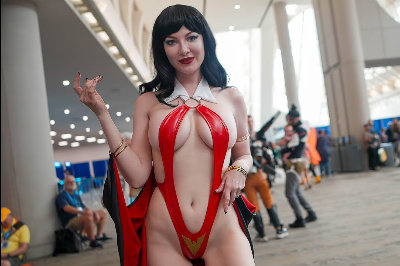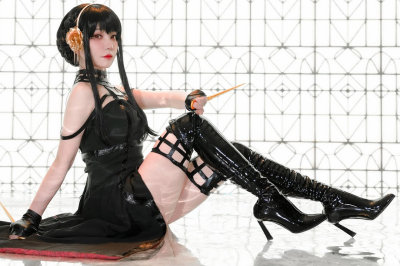When he was a child, Billy Bob Thornton used to dress up as Davy Crockett, the legendary American frontiersman. Today, the 48 year-old actor is back in Davy Crockett garb as the star of THE ALAMO, a sweeping historical drama that chronicles the bloody battle that pitted a handful of early Texas settlers against thousands of Mexican soldiers. The film is directed by John Lee Hancock and co-stars Dennis Quaid and Jason Patric as Sam Houston and Jim Bowie, respectively, two more key figures in the early days of the Lone Star State. “We’re all very proud of this,” says Thornton, who sports shoulder-length brown hair and long sideburns – both requirements for the role. The actor has been a Hollywood favorite ever since winning an Academy Award in 1997 for SLING BLADE, a film he wrote, directed and starred in. Subsequently, he’s earned acclaim for films like A SIMPLE PLAN and MONSTER’S BALL, opposite Halle Berry, and seems poised for another shot at an Oscar with THE ALAMO. During a recent visit to the film’s vast set on the outskirts of Austin, Texas, we talked to Thornton about critical acclaim, history lessons and portraying a boyhood hero.
Why did you want to play this character?
When I was growing up, every kid wanted to be Davy Crockett. I was born in Arkansas, and when you’re raised in this part of the country, that’s just who you want to be. So when I was offered the part I didn’t have to think twice about it. He’s a larger-than-life figure who is also very complex, and I felt I could play this character with many colors. It’s a dream come true.
So what kind of man was the real Davy Crockett?
Most people just know Davy Crockett as a guy who was a bear hunter and someone who swung his rifle at the Alamo and that was it. But he was a Congressman, and not everybody knows that. He was seen as a hillbilly Congressman and was actually ridiculed in Congress quite a bit when he first got there. So I’m portraying him not as some sort of macho hero, but as a real hero.
What do you mean by that?
A: If you totally have your mind made up to do something and then you do it, there’s not a lot of courage in that. There’s courage in having reservations about something, or not really knowing why you’re there, and then deciding to stay and actually becoming the last man standing. So I think the way we portray Davy Crockett, as well as all of the other main characters in this movie, is not only going to be satisfying dramatically to an audience, it’s going to be historically accurate.
Does that mean we won’t be seeing you in a raccoon hat with tail?
There is a scene in the movie where I wear a coonskin hat and buckskin clothes and all that stuff when I first get to town. I think the reason most people picture Davy Crockett that way is because back in his time they did a play about him and this guy who played him wore this ridiculous outfit with a coon skin hat with a bunch of tails, and that became the sort of romanticized version of Davy Crockett. But the thing is, Crockett was a legend in his own time. It wasn’t like he became a legend later on; he was a rock star then. And then this play came along and got the whole coonskin hat thing started, so when he would go around to see people, they expected this version of Davy Crockett. But he really preferred to be called David Crockett, especially once he became a Congressman. He wanted to be respected that way, you know, even though he was still kind of a hillbilly. But he was a very smart and very entertaining guy and people really liked him. He loved to tell stories and every now and then he would put on the hat and the clothes just to sort of live up to the legend. But that wasn’t really part of his normal wardrobe.
Is it fair to say that you have duplicated his look?
Yeah, I look just like him. It’s uncanny. If I showed you a picture of Davy Crockett, it would shock the hell out of you. I didn’t get this hair for the movie because I thought it was cool. I got it because it’s exactly like Crockett’s.
And you like the look?
I like looking like Davy Crockett, but I’ve liked the look of every other character I’ve played. If I played a three-eyed monster, I’d like the look.
How much did you know about the Alamo going into this project?
I studied the Alamo as much as anybody else did. When you’re raised in the United States, it’s a huge thing, the Alamo. But what you learn from the history books is just sort of a real general thing – you don’t really learn the details of it. All we knew was that the Texans fought the Mexicans, and Davy Crockett and Jim Bowie were there, and that was about the extent of it. As a student, you don’t really know the ins and outs of it. So before we started doing this movie I boned up on it and started reading more history books and learned that, as in anything, these people were human beings with a lot of different dynamics. It wasn’t like the people came to the Alamo to defend it just because it was a flag-waving thing. A lot of people wanted to come to Texas because it was a new land and they wanted to stake their claim. Plenty of wars have been fought over land and this was another one. This just happens to be one that stands out in history because of the numbers. It was like 189 inside the Alamo against a Mexican army of 4,000 – that’s why the Alamo has become so legendary.
Because you’re taking on such a momentous event and showing these characters as real people, and not one-dimensional heroes, are you at all concerned about how this film will be perceived?
In the beginning I was a little nervous because we’re making a historically accurate movie and you wonder, what will Texans think? But we’re actually doing something that I think will make Texans proud. We’re making a movie that is based in fact and is as close as you can get to the diaries and books. At the same time, we’re giving people a good drama that has moments of humor. So it’s an honor to do this and everybody who’s here working on this movie wants to be here. Usually when you’re making a movie, you can tell about halfway through if it’s the real thing, and this one is.
As a veteran actor and director, can you sense early on how a film is going to be received by critics?
I quit trying to project what a movie is going to do or how people are going to receive it a long time ago. A lot of movies that are horrible do very well and sometimes even the critics like them and you think, how could they like that? Other times movies are really good and don’t get noticed and the critics don’t quite get them. You never know what’s going to happen. As for this film, I hope people understand that it’s a movie about the pursuit of happiness, land and the future.
Considering what’s going on in the world today, are there lessons to be learned from the Alamo?
I don’t have anything really insightful or deep to say about how the Alamo compares to what’s going on in the world right now. In fact, I don’t have any views to express about politics. When people asked Elvis Presley about the Vietnam War, he said, “Frankly, I’m just an entertainer.” That’s kind of the way I look at it. I’m lucky to get my pants on in the morning.
Because the set for this film is so massive, is it easy for you to transport yourself, mentally, to another time?
Definitely. You look around and you feel like it’s 1836, especially when you go out there and you’ve got the clothes on and everybody else does too, particularly for those big scenes where everybody’s in the Alamo at once and there’s wagons and horses around and you don’t see the crew because they’re shooting a wide shot. So the environment always helps me as an actor. When I did A Simple Plan, the snow and the cold were just part of the acting process. I love that.
How physically demanding has this film been?
It has been pretty demanding, actually. Some guys had to learn horsemanship and that kind of thing, and we all learned to use flintlock weapons and muskets. For those of us who already knew how to shoot guns, we had to start all over because it’s a whole different process with these weapons. So there was stuff to learn, but really what’s been the most physically demanding part is shooting at night for long periods of time. You’re out there at night in a lot of clothing, but it’s never enough when it’s freezing and it’s too much when it’s hot. And we’ve had weather troubles – rain and extreme cold and extreme heat. And then there’s a lot of stuff burning so there’s a lot of smoke and the crew had a lot of respiratory trouble. So it’s been hard, but when you’re working on a film like this where the crew is great and the director is great, you don’t worry about that stuff so much. Every time we go out there we’re making a piece of history. This is more than likely the last movie about the Alamo they’ll ever make – I mean, certainly in our lifetime – and I’m proud to be a part of it.
Question & Answer Text Copyright Buena Vista International



